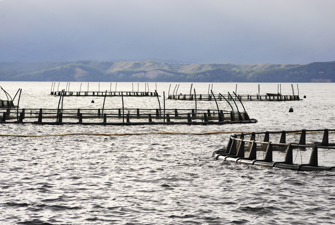Creating a liveable sporting future through climate leadership, environmental justice and citizen science
OPINION: In sport, three areas stand out when it comes to handling the dilemma of communicating the need for marked reduction of carbon emissions whilst also conducting activities with ecological footprints. Brett Hutchins points to the importance of climate leaders in sport, the interweaving of climate action with environmental justice, and the role of citizen science.
Brett Hutchins is a professor of Media and Communications at Monash University in Melbourne, Australia. This article is based on insights developed from an Australian Research Council funded project.
Opinions on playthegame.org reflect the views of the author(s).
Sport around the world offers a rare source of mass communication and media power in an age of fragmenting audiences, technologies, and politics. Grounded in sport’s popularity and visibility, it is a power that underlines the relevance and role of sport in addressing climate change impacts and environmental issues more broadly.
In the case of the climate emergency, this capacity has been used by the global fossil fuel industries and high-carbon polluters to greenwash their environmental scorebook through lucrative sponsorships and advertising. But now there is also growing evidence that this power is deployed to envision a sporting world in which significantly reduced carbon emissions are the norm, not the exception.
These contentious dynamics are revealed by research my collaborators and I have completed on sport and the communication of environmental issues. Funded by the Australian Research Council, the Greening Media Sport project investigates a fundamental dilemma faced by all sports: how to communicate the need for systemic large-scale change to radically reduce carbon emissions while, at the same time, conducting sporting activities and events that generate unavoidable ecological footprints.
Three areas stand out in terms of how this dilemma is being confronted productively in an effort to create positive change: the rise of climate leaders in sport; the interweaving of climate action with environmental justice; and the role of citizen science.
Leading the way
Leadership on climate action is urgently needed given the continuing prevalence of climate change scepticism and outright denial on social media and in reactionary news media. A primary example is Pat Cummins, the reigning International Cricket Council Men’s Cricketer of the Year and Australian national captain. Cummins offers a compelling example of leadership that combines concrete climate action with outstanding sporting performance.
Cricket is particularly susceptible to climate change impacts, including extreme heat, drought, and flooding. Cummins founded Cricket for Climate in 2022, an organisation working to install solar power at 4,000 cricket clubs across Australia. He has hosted a private summit for cricketing and sporting powerbrokers to address how cricket can reduce its carbon footprint. His tenure as captain coincides with the removal of a fossil fuels energy retailer, Alinta Energy, as the major sponsor of Cricket Australia.
Derisively labelled ‘Captain Woke’ and ‘Captain Planet’ in some quarters, Cummins has been subject to sharp criticism by Murdoch-family controlled News Corporation media outlets such as Sky News in Australia. However, it is interesting to observe Cummins’ composure and clarity when discussing climate change, even in the face of hostile media coverage, as in this example from the Sydney Morning Herald:
"The data says we’re not doing enough to reduce carbon emissions and mitigate the worst aspects of climate change, including extreme heat and natural disasters."
His approach suggests an acute awareness of his prominence and privilege as a national men’s sporting captain. Cummins only needs to speak clearly for his words and actions to be reported widely and taken seriously in cricketing countries and regions such as Australia, New Zealand, India, Pakistan, England, and the West Indies.
Climate action powered by environmental justice
In the US, Vermont Green FC offers a unique vision of a football club founded on the bedrock of environmental justice. Emerging from environmental and related social movements, this notion of justice promotes an ecologically-centred ethics and sensibility that encourages a respectful and harmonious attitude towards nature. Pervasive digital media and communications both reflect and constitute the realisation of environmental justice at this moment in time.
Vermont Green FC launched in 2022. Playing in USL League Two, the club has attracted media attention from the likes of BBC Sport and The Guardian despite its standing in lower division football.
The club recalls examples such as the better-known Forest Green Rovers FC in the UK, and a remarkable network of European clubs and partners working together under the banner of Football for Climate Justice. The network includes Bohemian FC (Ireland), Club Brugge (Belgium), FC St. Pauli (Germany), FC Twente (Netherlands), Ferencvárosi TC (Hungary) and Real Betis (Spain). Driven by a series of environmental and community initiatives and reports, this network is working to both ‘reduce the carbon footprint of football’ and ‘use football as a tool for social and environmental progress’ among fans and in their local communities.
Vermont Green FC offers a distinctive emphasis on the relationship between environmental stewardship, human rights, antiracism and equality and states on its website: ‘We believe soccer [football] can be a powerful catalyst for a more environmentally sustainable and socially just world’. The club's co-founder and chief purpose officer, Keil Corey, explained the club’s mission to us in the following way:
"We arrived at environmental justice as the lens through which we would look at club operations, club strategy and how we build a culture around that … That led to deeper conversations around climate justice, which is the idea that climate change disproportionally affects people of low income, people of colour, and other marginalised groups. So really it was getting at the roots, that social justice issues are at the heart of climate change, as well as many environmental issues."
This philosophy is evident in the club’s decision to join ‘1% for the Planet’, which involves donating one percent of annual sales to non-profits working on behalf of the environment. Club merchandise sales have been made to followers in over 40 US states, with merchandise sourced from suppliers using recycled and upcycled materials, organic cotton, and renewable energy during production processes.
Now three playing seasons into their existence, Vermont Green’s philosophy is an appealing proposition for fans. Corey reports that 80-90 percent of surveyed supporters wished more sports clubs prioritised environmental issues.
RinkWatch traces changing temperatures across North America and their impact on outdoor ice rinks and skating. Photo: Adam and Kev / Getty Images
Citizen science and climate change data
Community engaged and led movements can be a useful corrective to failures of sustained political leadership in action on climate change. Citizen science research offers a means to partly bypass misleading political and media messages and to engage recreational sports people in monitoring environmental and climactic change in their communities. This engagement also signals a shift from away from communicating with people who mainly watch sport, towards those who participate and play.
RinkWatch is a leading example of citizen science in sport. Led by Robert McLeman and Colin Robertson from Wilfred Laurier University in Canada and backed by a team of student researchers, RinkWatch traces changing temperatures across North America and their impact on outdoor ice rinks and skating.
It also complements the activism of high-profile non-profits such as Protect Our Winters (POW). Founded by US professional snowboarder, Jeremy Jones, in 2007, POW now features a European arm and focuses on advocating for policy and political change.
Having commenced in 2013, RinkWatch boasts over 1,400 volunteers who log temperature data and skating conditions for their local rinks. Analysis of the accumulated data is presented in annual skating season reports, journal articles, and media interviews, including for Sports Illustrated, The New York Times and CBC National News.
Published in Canadian Geographies journal, the climate predictions for the 2050s and 2080s generated by RinkWatch data make for jarring reading: "… many North Americans who build outdoor rinks every winter will, by mid-century, be living in areas where temperatures are only cold enough to do so occasionally, creating a range of social, cultural, and health implications for people living in those regions."
The implications of such changes extend to skiing, snowboarding, and sledding. Citizen science offers a mechanism to raise awareness of how these changes impact on communities, which can then filter outwards to sporting federations, local and state governments, and news media.
The future is already here, but which one(s)?
"The future is already here – it’s just not evenly distributed." Attributed to speculative fiction writer, William Gibson, this observation cuts different ways in the context of sport and climate change in the coming decades.
A pessimistic reading of Gibson’s statement anticipates a future of climbing carbon emissions, record breaking temperatures, extreme weather events, fossil fuel sponsorships and greenwashing across the sports industries. As David Goldblatt identifies in examining the 2023 African Cup of Nations, the dependence of the contemporary world football economy on hydrocarbon industry sponsorships and largesse offers ‘only more extraction, more pollution and more global heating’.
An optimistic reading of Gibson’s statement suggests that the examples of leadership, environmental justice, and citizen empowerment presented in this article are set to become more widespread across the world. Responding to public and fan demands about the need for action for climate action, the people who play and control sport will embrace the power of their communication platform, work to reduce carbon emissions, and expand sustainable environmental practices and supply chains.
These differing scenarios encompass contrasting responses to the fundamental dilemma faced by all sports, athletes, and officials in the midst of the climate emergency – averting the worst impacts of climate change while simultaneously leaving an ecological footprint.
The tensions triggered by this dilemma can be problematic and productive, with the balance shifting over time as problems change and the consequences of decisions and actions unfold. The examples presented in this article emphasise the value of working productively with this dilemma in the process of communicating the need for urgent action in the service of a liveable future. The alternative is to let sport and the world continue to overheat and burn.


